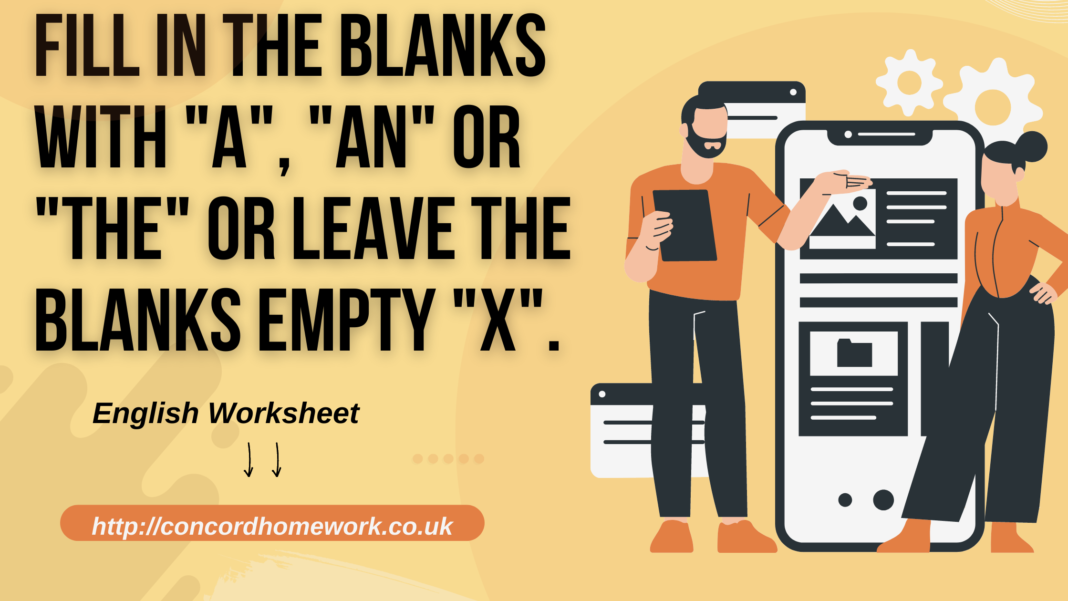Fill in the blanks with “a”, “an” or “the” or leave the blanks empty “x”.
This worksheet is about practicing the articles a, an, or the. Students read the sentences and choose the most appropriate article. The worksheet has an answer key.
Download this English worksheet: Articles Grammar worksheet a, an , the English worksheets download Best English Worksheets.
Definite Article:
-
The: The definite article “the” is used before singular or plural nouns when the noun is specific or already known to the reader/listener. It indicates that the speaker is referring to a particular person, thing, or group.
- Example: “I saw the cat in the garden.” (The speaker is referring to a specific cat and a specific garden.)
Indefinite Articles:
-
A: The indefinite article “a” is used before singular nouns that begin with a consonant sound. It indicates that the noun is nonspecific or unknown to the listener/reader.
- Example: “I bought a book yesterday.” (The speaker is referring to any book, not a specific one.)
-
An: The indefinite article “an” is used before singular nouns that begin with a vowel sound. Like “a,” it also indicates nonspecificity or unknownness.
- Example: “She is an excellent student.” (The speaker is referring to any excellent student, not a specific one.)
Articles Table:
| Article Type | Use | Example |
|---|---|---|
| Definite Article | Used before specific nouns known to the reader/listener | The cat in the garden |
| Indefinite Article | Used before nonspecific or unknown nouns | I bought a book yesterday |
| Indefinite Article | Used before singular nouns beginning with a vowel sound | She is an excellent student |
Usage Tips:
- “A” is used before words that begin with a consonant sound, while “an” is used before words that begin with a vowel sound.
- “The” is used when referring to something specific or known to the reader/listener, while “a” and “an” are used when referring to something nonspecific or unknown.
- Articles are always placed before the noun they modify.
“Understanding the Definite Article ‘The’ in English: Usage and Circumstances”
-
Specific Nouns: “The” is used before singular or plural nouns when the noun is specific or known to the reader/listener.
- Example: “I saw the cat in the garden.” (The speaker is referring to a specific cat and a specific garden.)
-
Unique Objects: “The” is used before nouns that represent unique or one-of-a-kind objects, concepts, or locations.
- Example: “He visited the Eiffel Tower.” (There is only one Eiffel Tower.)
-
Superlative Forms: “The” is used before superlative adjectives to indicate the highest degree or most extreme quality of something.
- Example: “She is the tallest girl in the class.” (The speaker is referring to the girl with the highest height.)
-
Ordinal Numbers: “The” is used before ordinal numbers to indicate a specific position or order in a sequence.
- Example: “He finished the first lap in the race.” (Referring to the specific lap that was first in order.)
-
Familiarity: “The” is used when the noun has been previously mentioned or is already known to the reader/listener.
- Example: “She lost her keys. The keys were later found in her bag.” (Referring back to the keys that were previously mentioned.)
-
Geographical Features: “The” is used before the names of certain geographical features, such as rivers, oceans, mountain ranges, and deserts.
- Example: “The Nile is the longest river in the world.” (Referring to the specific river named “Nile.”)
-
Unique Groups or Organizations: “The” is used before the names of unique groups, organizations, or institutions.
- Example: “He works for the United Nations.” (Referring to the specific organization known as “United Nations.”)
-
Musical Instruments: “The” is used before the names of certain musical instruments.
- Example: “She plays the piano.” (Referring to the specific instrument known as “piano.”)
Sharing is caring. Encurage our teachers to create more




















